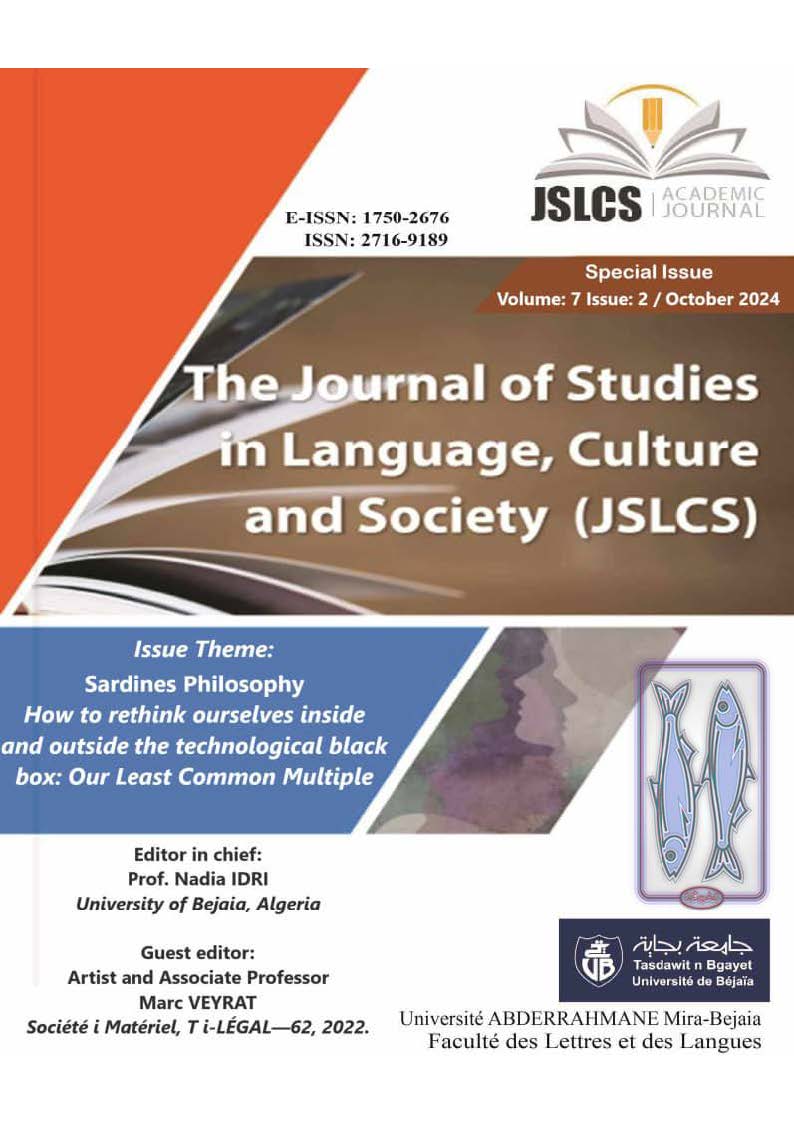Cultural Globalization And The Use Of Taboos On Tiktok Platform Amongst Algerian Youth
Keywords:
Algerian society, cultural globalization, taboos, TikTok platformAbstract
Cultural globalization is a nascent phenomenon that endangers local cultures globally. Platforms like TikTok usher the rapid dissemination of global trends and values which can potentially undermine traditional societal norms and principles. This paper aims to gauge the impact of cultural globalism on the portrayal of taboos among Algerians on TikTok via a semi-structured questionnaire. Deploying the quantitative method, the data revealed the prevalence of taboos embraced by the younger generation, particularly, as a result of the massive exposure to western cultures. To this end, a set of recommendations were proposed to preserve national identity from obliteration, emphasizing broader implications for safeguarding local cultures beyond Algeria in a globalized digital era.
References
Bakhouche,C., & Retimi, A. (2022). Social media sites and their role in producing deviant behavior among young people (tiktok model). Horizons Journal of Sociology ,12(1), 202-220
Banerjee, S. B., & Linstead, S. (2001). Globalization, multiculturalism and other fictions: colonialism for the new millennium? Organization, 8(4), 683–722.
Beck, U. (2003). What is globalization? Errors of globalism – responses to globalization. UK: Polity Press.
Blum, D. W. (2007).National identity and globalization: Youth, state, and society in post-Soviet Eurasia. Cambridge University Press.
Corley, K. G. 2004. Defined by our strategy or our culture? Hierarchical differences in perceptions of organizational identity and change, Human Relations, 57(9), 1145-1177.
Evenett, S.J., 1999. The World Trading System: The Road Ahead. Finance & Development 36(4), 22-25.
Friedman, L, T. (2002). Longitudes and attitudes. Farrar, Straus and Giroux.
Giddens, A. (2002). Runaway world how globalisation is reshaping our lives. Profile Books.
Guo, J. (2021). Research on the influence of TikTok on teenagers, Advances in Social Science, Education and Humanities Research, volume 631, 1390-1393
Hamelink, Cees. 1988. Cultural autonomy in global communications: Planning national information policy. London: Centre for the Study of Communication and Culture.
Hofstede, G., Hofstede, G. J., & Minkov, M. (2010). Cultures and organizations: Software of the mind (3rd ed.). McGraw-Hill. Hopper, P. (2007). Understanding cultural globalization. Polity Press.
Huntington, S. (1993). The clash of civilizations. Foreign Af airs, 72(2), 22-49. https://doi.org/10.2307/20045621
Kemp, S. (2023). Digital 2023: Algeria. Retrieved March 20, 2024, fromhttps://datareportal.com/reports/digital-2023-algeria
Kennedy, T. (2020). The Impact of TikTok on Girls During the Pandemic: A Liberation of Girlhood or Cause for Concern? International Coalition of Girls' Schools. Retrieved from https://www.agsa.org.au/research/the-impact-of-tiktok-on-girls-during-the-pandemic-a-liberation-of-girlhood-or-cause-for-concern-kennedy-2020/
Lajnef, K. (2023). The effect of social media influencers' on teenagers behavior: an empirical study using cognitive map technique, Current Psychology, 42(5), 19364–19377
Lamouri,A.,& Nahal, S. (2022). The impact of digital media on the social values of the Algerian teenager: TikTok is a model. International Journal of Social Communication, 9(2), 242-257
Lee, E. (1996). Globalization and employment: Is anxiety justified?. International Labour Review, 135(5), 486-497.
Liu, S., Volcˇicˇ, Z., & Gallois, C. (2015). Introducing intercultural communication : Global cultures and contexts. SAGE.
Matos, C. (2012). Globalization and the mass media. In G. Ritzer (Ed.), The Wiley-Blackwell’s encyclopaedia of globalization, pp-1329-1339. Oxford: Wiley-Blackwell. https://openaccess.city.ac.uk/id/eprint/5542/
Matsumoto, D. (1996). Culture and psychology. Pacific Grove, CA: Brooks/Cole.
McQuail, D. (2005). McQuail’s mass communication theory. London: Sage Publications.
Miller, V. (2020). Understanding digital culture. London: Sage Publications Ltd.
Pfister, T.(2000). Citizenship and Globalization. Ethnopolitics, 4(1) ,105– 113
Qanbar, N. (2011). A sociolinguistic study of the linguistic taboos in the Yemeni society. Modern Journal of Applied Linguistics, 3(2), 86-104.
Raras, A., & Sudarwati, E. (2021). What you are is what you say: An analysis of taboo words on TikTok, Jurnal KATA, 5(2), 321-332
Seddiki, M.C. (2018). The inclusion of cultural content in civilization course classes: Aprocedure to motivate students or frustrate them? In Journal of Studies in Language, Culture and Society, 01(01), 57-71
Seelye, H. N. (1997). Teaching culture: Strategies for intercultural communication. National Textbook Company.
Skare M. and Soriano, D. (2021). How globalization is changing digital technology adoption: An international perspective. Journal of Innovation and Knowledge, 6(4), 222-233. https://10.1016/j.jik.2021.04.001
Start.io. (2023). Tiktok Users in Algeria. Retrieved March 20, 2024, fromhttps://www.start.io/audience/tiktok-users-in-algeria
The Levin Institute.(2013). Culture and globalization. Globalization101. Retrievedfromhttps://www.globalization101.org/
Tomlinson, C. A. (1999). The dif erentiated classroom: Responding to the needs of all learners. Association for Supervision and Curriculum Development
Wardhaugh, R. (2010). An introduction to sociolinguistics. Wiley-Blackwell. Wenger, E. (1998). Communities of practice: Learning, meaning and identity. CambridgeUniversity Press








